Still more or less under quarantine shutdown due to COVID19, I haven’t been doing much outdoor stuff over the past several months. What with the pandemic and horrid air quality due to wildfires throughout the state, spending time in places I would normally like to hang out simply hasn’t been possible. We’re still getting too many out-of-the-area visitors for me to feel comfortable being around people, and weekends are especially bad. But last weekend I went to Moss Landing to take pictures of birds and other wildlife—I needed visual aids for a virtual lab my students will be doing in a few weeks.
It’s the time of year for birdwatchers to get excited about winter visitors. I’ve had golden-crowned sparrows in the canyon behind the house for almost a month now, but I hadn’t been down to a beach in a while. Moss Landing is a great place for birdwatching, because you can explore the estuarine habitat of Elkhorn Slough, the sandy beach, and the harbor during a 2-mile walk. That’s three distinct habitats for very little effort!
Starting at the tidal marsh, I always keep an eye out for the long-billed curlew (Numenius americanus). They have the largest beak-to-head ratio of any bird.
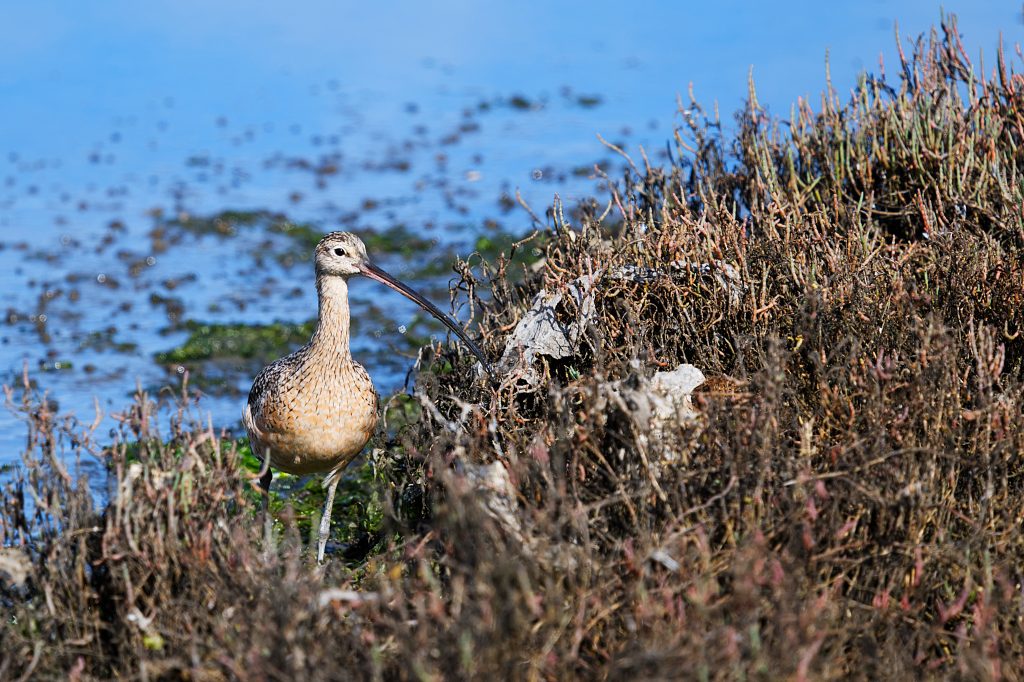
2020-10-10
© Allison J. Gong
One of my favorite winter visitors to the marsh area is the willet (Tringa semipalmata). Unlike most shorebirds that are speckled or mottled, willets in winter plumage are a beautiful soft gray-ish brown color. Every time I see a willet I ask myself, “Willet, or won’t it?”
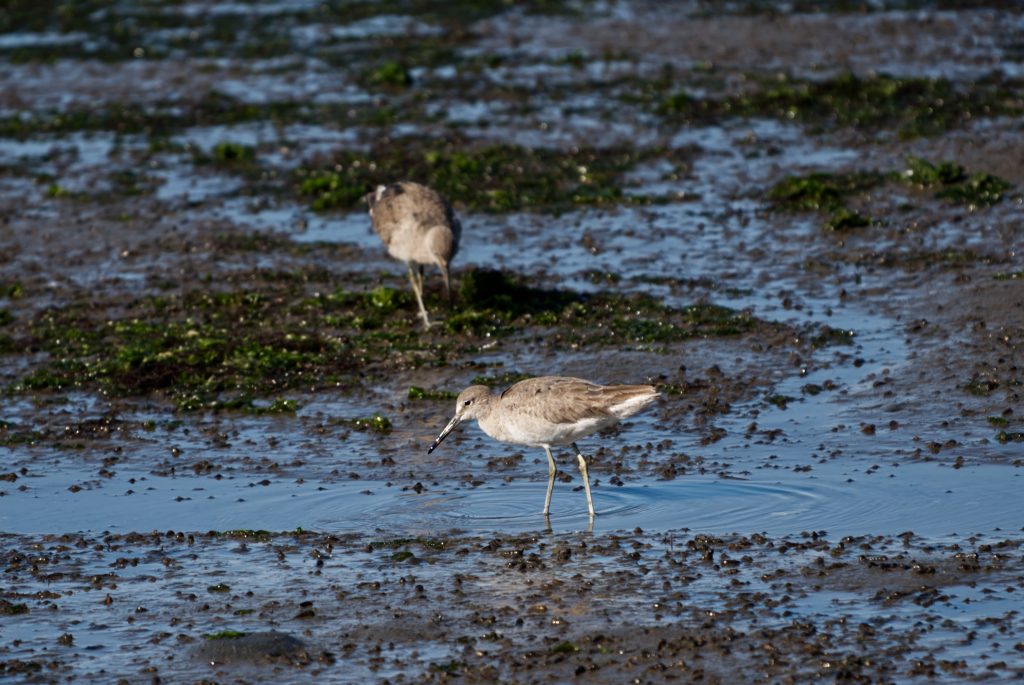
2020-10-10
© Allison J. Gong
And when they take off in flight, willets show these striking black and white wing patterns. They always take me by surprise, even though I know to expect it.

2020-10-10
© Allison J. Gong
A whole flock of willets taking off at once is quite an impressive sight!

2018-11-14
© Allison J. Gong
From the marsh it’s a short walk over the dune and onto the beach.
I always look forward to walking this beach because of the dead things. Don’t get me wrong, the living things are fun to see, but in some ways the dead critters can be more informative. For every species there is always some baseline level of mortality in the ocean, so you expect a certain number of dead things to wash up. However, an unusually high number of corpses could indicate that something is going on at sea. This trip I didn’t see very many dead critters: just a few grebes that had been there for a while, nothing out of the ordinary.
Oh, and an otter pup. At least, I’m pretty certain it was an otter.
Yes, we came across a dead sea otter pup, my first ever.
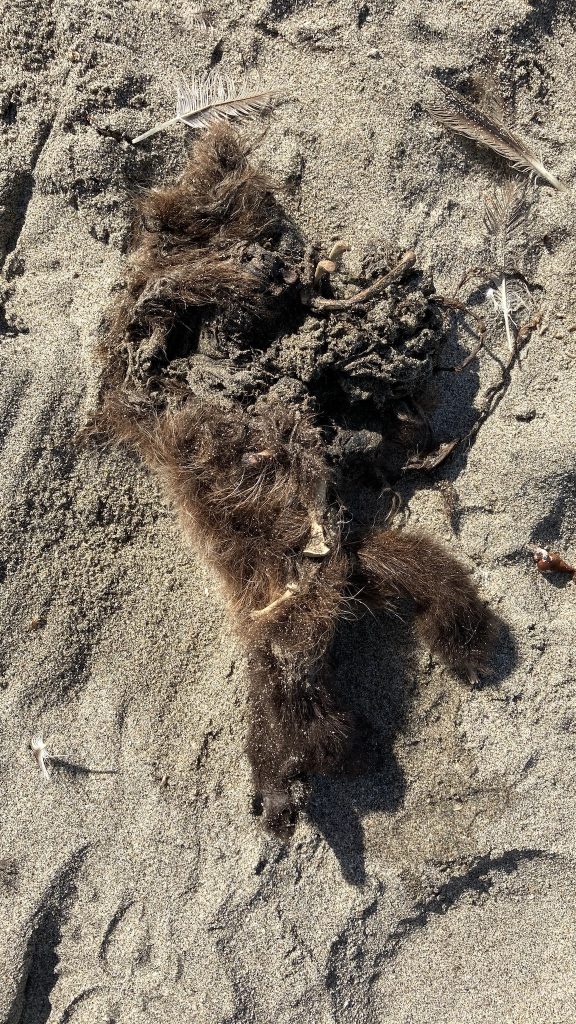
2020-10-10
© Allison J. Gong
The body was missing a head, but the parts that remain were a bit longer than my booted foot. Although most of the soft tissue had been scavenged, the carcass had distinct paws, meaning it wasn’t any kind of pinniped (seal or sea lion). Also, pinnipeds don’t have fur like this, as they rely on blubber for thermoregulation. Sea otters, on the other hand, have the densest fur of all mammals, with the oft-cited 1 million hairs/in2.
But let’s be honest. I like the beach because I like photographing birds, and there is always interesting bird life at this beach. I’m not one of the crazy bird people who keep a life list and need to be the first person to spot a particular something-or-other. And, unlike the idiots I saw tramping through the pickleweed in pursuit of a Say’s phoebe that day, I don’t climb over fences and trespass where I’m not supposed to be. Besides, even the everyday backyard birds are fun to watch. Whoever says that familiarity breeds contempt certainly is not a naturalist!
And who doesn’t love a snowy plover or two?
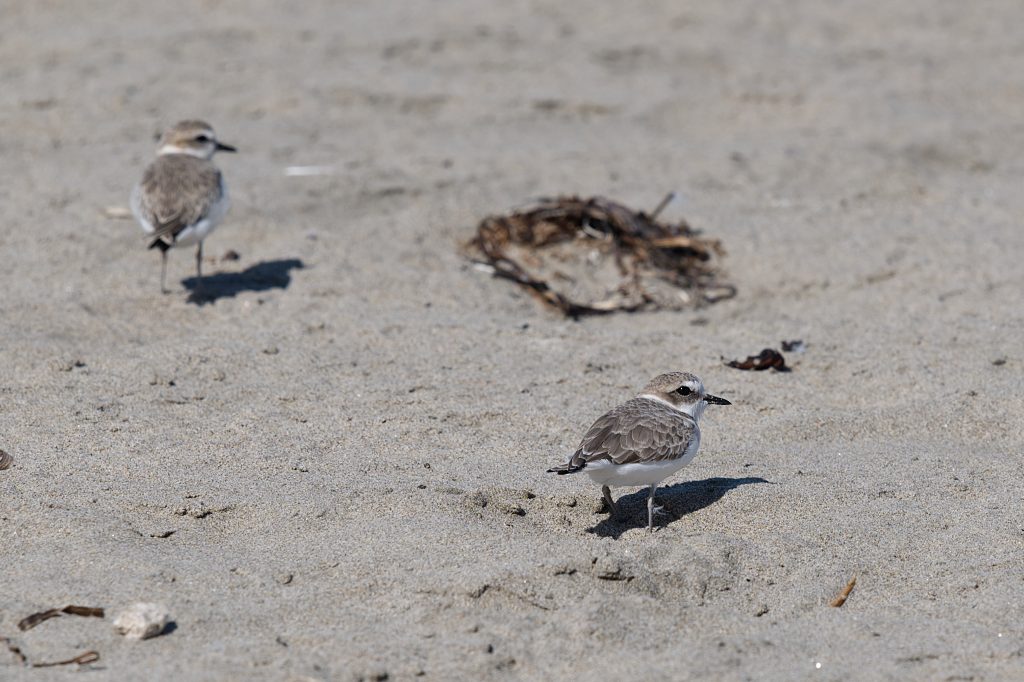
2020-10-10
© Allison J. Gong
The snowies aren’t nesting at this time of year so the upper part of the beach isn’t roped off. They do still get disturbed by people wandering around, who probably don’t even know the birds are there. They (the snowies, that is) are so tiny that when they hunker down behind a divot in the sand they disappear completely. If you sit or stand quietly, they will pop up and make short dashes from hillock to pile of beach wrack and back again, feeding on the insects and crustaceans they find.
In addition to the snowy plovers, another tiny “peep” bird runs around on the beaches, often in large groups. These are the sanderlings, Calidris alba. I’ve only ever seen them in nonbreeding plumage, as they nest in the high Arctic.
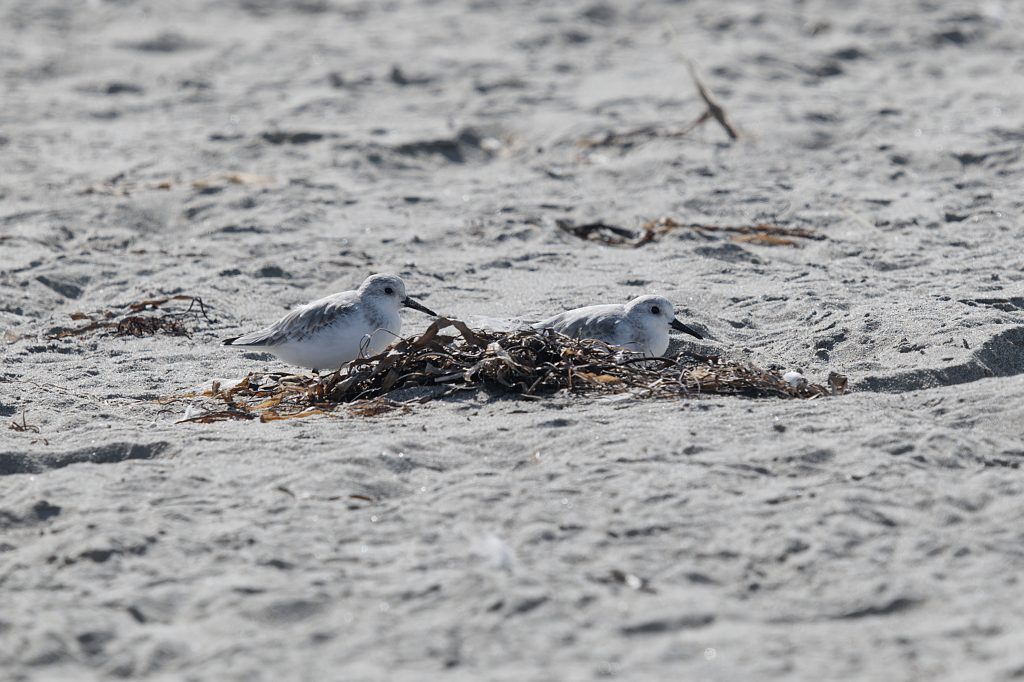
2020-10-10
© Allison J. Gong
Sanderlings are the little birds that run back and forth from the waves. As a wave recedes the sanderlings frantically stab their stout beaks into the sand, grabbing up small mole crabs and other crustaceans that are right at the surface. When the next wave arrives the sanderlings run back up the beach. They have short legs and don’t swim, so getting swept out to sea would be a very bad thing for them.
Sometimes even the long-legged shorebirds forage on the beach. I’ve seen the curlew there, as well as whimbrels and godwits. This day the godwits were stealing the show.
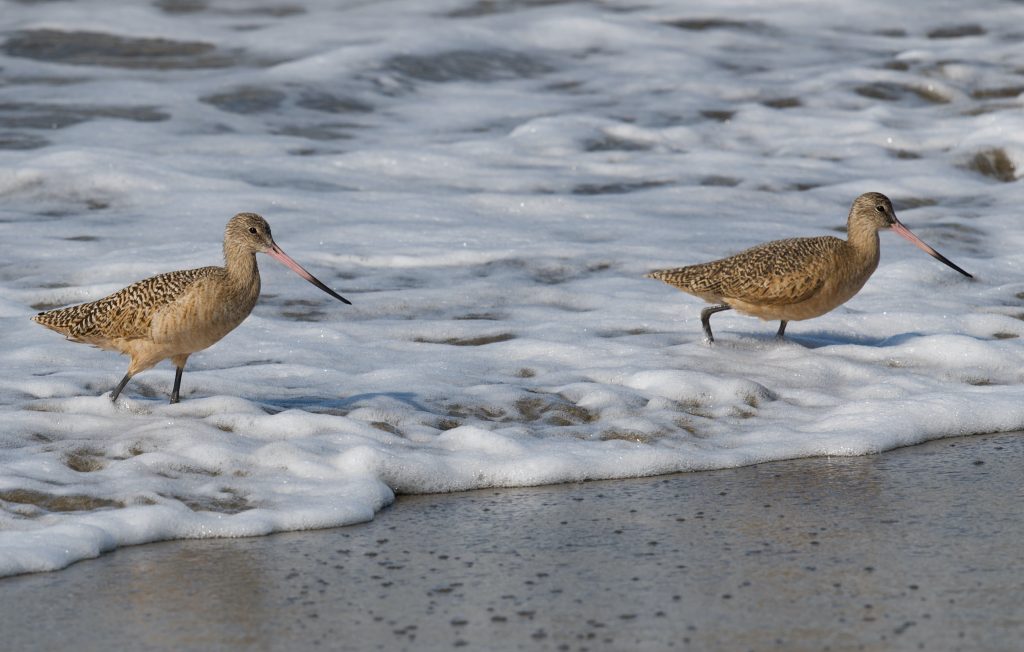
2020-10-10
© Allison J. Gong
The godwits, with their longer legs, are able to stand their ground when the waves wash up. They can catch food that is buried more deeply into the sand. On mudflats they pick their way over the flat at low tide, digging for worms, clams, and crustaceans. They can feed on a mudflat only at low tide. But on the beach they can feed at any time, just moving with the tide as it floods and ebbs.
And my friend the long-billed curlew was there on the beach, too!
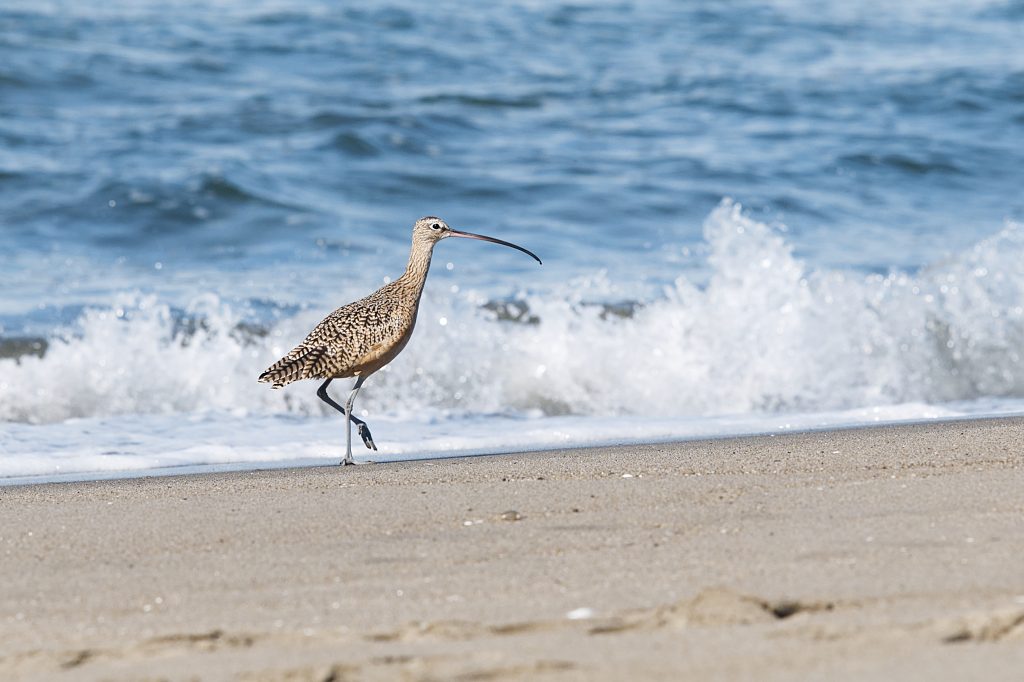
2020-10-10
©Allison J. Gong
The curlews are not as eager to forage in the waves themselves as the godwits seem to be. The curlews might wander down to where their ankles are swashed by the waves, but do not seem to like getting wetter than that. But that bill can probe very deeply into the sand or mud. I’ve watched them feeding on mole crabs on the beach, and on worms on the mudflats.
Autumn and winter are good times to watch birds around here. There’s a bit of a lull in bird activity once the swallows leave depart for the south and before the winter residents show up. For me, autumn begins when the golden-crowned sparrows arrive in the neighborhood, which this year was September 25. I’m listening to them now as I write this! Being located on the Pacific Flyway means we get lots of birds resting for a bit on their migration even if they don’t winter here. I’ll try to get out to Moss Landing during the winter months, to keep track of the avian comings and going.
